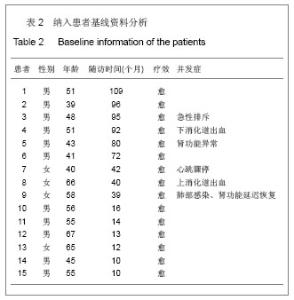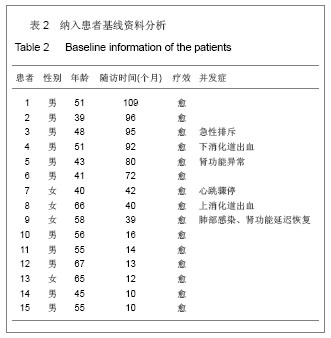| [1] Davis CL, Gonwa TA, Wilkinson AH. Identification of patients best suited for combined liver-kidney transplantation: part II. Liver Transpl. 2002;8(3):193-211.[2] Rugin? M, Predescu L, S?l?gean M, et al. Pre-liver transplantation, cardiac assessment. Chirurgia (Bucur). 2012;107(3):283-290.[3] Bilbao I, Charco R, Balsells J, et al. Risk factors for acute renal failure requiring dialysis after liver transplantation. Clin Transplant. 1998;12(2):123-129.[4] Markmann JF, Markmann JW, Markmann DA, et al. Preoperative factors associated with outcome and their impact on resource use in 1148 consecutive primary liver transplants. Transplantation. 2001;72(6):1113-1122.[5] Liu XY, Yu LX. Zhonghua Qiguan Yizhi Zazhi. 2000;5:319-320.刘小友,于立新. 肝、肾联合移植的适应证[J].中华器官移植杂志, 2000,5:319-320.[6] Fong TL, Khemichian S, Shah T, et al. Combined liver-kidney transplantation is preferable to liver transplant alone for cirrhotic patients with renal failure. Transplantation. 2012; 94(4):411-416.[7] Giralt G, Madrid A, Garrido M, et al. Reversal of Hyperoxaluric Cardiomyopathy With Severe Cardiac Dysfunction After Combined Liver and Kidney Transplantation. Rev Esp Cardiol. 2012 Sep 24.[8] Sharma P, Schaubel DE, Messersmith EE, et al. ctors that affect deceased donor liver transplantation rates in the United States in addition to the model for end-stage liver disease score. Liver Transpl. 2012;18(12):1456-1463.[9] Sun XY, Qin K, Nong J, et al. Zhonghua Shiyan Waike Zazhi. 2012;29(10):1934-1937.孙煦勇,秦科,农江,等.肝肾联合移植术后T细胞亚群变化及其共刺激分子的表达[J].中华实验外科杂志,2012,29(10):1934- 1937.[10] Du GS, Shi BY, Zheng DH, et al. Junyi Jinxiu Xueyuan Xuebao. 2012;33(1):3-5.杜国盛,石炳毅,郑德华,等. 15例肝肾联合移植报告[J].军医进修学院学报,2012,33(1):3-5.[11] Song JY, Shi BY, Du GS, et al. Zhongguo Zuzhi Gongcheng Yanjiu yu Linchuang Kangfu. 2010;14(53):9953-9956.宋继勇,石炳毅,杜国盛,等.肝肾联合移植患者免疫抑制剂的应用[J].中国组织工程研究与临床康复,2010,14(53):9953-9956.[12] Gringeri E, D'Amico FE, Bassi D, et al. Liver transplantation for massive hepatomegaly due to polycystic liver disease: an extreme case. Oncol Lett. 2012;3(5):1007-1010.[13] Ueno T, Barri YM, Netto GJ, et al. Liver and kidney transplantation for polycystic liver and kidney-renal function and outcome. Transplantation. 2006;82(4):501-507. [14] Gonwa TA, McBride MA, Anderson K, et al. Continued influence of preoperative renal function on outcome of orthotopic liver transplant (OLTX) in the US: where will MELD lead us? Am J Transplant. 2006;6(11):2651-2659.[15] Yang CH, He XS, Chen J, et al. Fungal infection in patients after liver transplantation in years 2003 to 2012. Ann Transplant. 2012;17(4):59-63.[16] Davis CL. Impact of pretransplant renal failure: when is listing for kidney-liver indicated? Liver Transpl. 2005;(11 Suppl 2): S35-44.[17] Feng S, Trotter JF. Can we stop waiting for godot? Establishing selection criteria for simultaneous liver-kidney transplantation. Am J Transplant. 2012;12(11):2869-2870.[18] Gallon L, Akalin E, Lynch P, et al. Continued influence of preoperative renal function on outcome of orthotopic liver transplant (OLTX) in the US: where will MELD lead us? Am J Transplant. 2006;6(11):2651-2659. [19] Ruiz R, Kunitake H, Wilkinson AH, et al. Long-term analysis of combined liver and kidney transplantation at a single center. Arch Surg. 2006;141(8):735-741.[20] Ruiz R, Kunitake H, Wilkinson AH, et al. Long-term analysis of combined liver and kidney transplantation at a single center. Arch Surg. 2006;141(8):735-741.[21] Fong TL, Bunnapradist S, Jordan SC, et al. Analysis of the United Network for Organ Sharing database comparing renal allografts and patient survival in combined liver-kidney transplantation with the contralateral allografts in kidney alone or kidney-pancreas transplantation. Transplantation. 2003; 76(2):348-353. |

